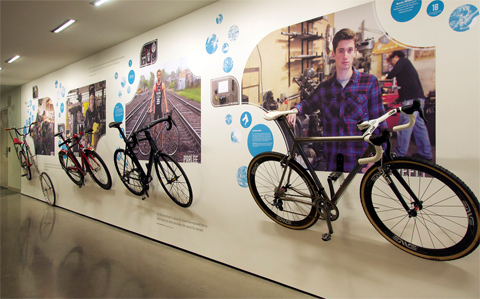
ALT ENERGY The bikes on display at the BSA Space include sleek couture designs as well as cycling gang Scul's part-circus, part—Mad Max choppers. |
A hit of the 1939 New York World's Fair was General Motors' "Futurama," a vast model landscape lined with superhighways that arrived at a metropolis of gleaming skyscrapers. Traffic congestion was reduced by running limited-access highways through the city's heart — and eliminating most pedestrians and trees. It epitomized midcentury urban planning: all glass and steel and concrete, all machines and fossil fuels, little green.
In retrospect, the flaws are obvious. And it explains why Boston's old West End was leveled, City Hall got erected, and global warming heated up.
Slowly, communities have tried to heal the damage — in Boston, the Big Dig buried the Central Artery highway that had divided downtown. We've begun to embrace urban farming, energy conservation, and biking.
"Let's Talk About Bikes" at BSA (Boston Society of Architects) Space (290 Congress St, Boston, through August 31) surveys "the role of the bike in Boston's physical and cultural transformation." Some 52 miles of bike lanes have been added here since 2008. Hubway launched a bike-sharing program last year. And custom bike manufacturers have blossomed.
Organizers Mark Pasnik, Chris Grimley, Michael Kubo, and associates from the Boston architecture and design firm over,under and pinkcomma gallery showcase 16 bikes — mainly sleek, form-follows-function, couture designs by local firms. Seven Cycles' Berlin Bike has a belt drive instead of chain. Parlee Cycles' Z5 SLi is a strong, super lightweight carbon-fiber racing bike. Saila Bicycles' Speed/Track is a fixed-gear bike. Royal H Cycles' Bendix Bike uses lugs rather than welding at the joints. Firefly Bicycles' Ti Cross cyclocross bike has an integrated seat post, which allows the brake cable to be routed inside the top tube. The titanium frame is left unpainted — logo and decorative patterning are anodized on — to show off the materials and elegance of its construction.
The exception to this svelte minimalism is Scul, a cycling gang that reconstructs old bikes into awesome part-circus, part–Mad Max choppers that they tool around Somerville. On display is their first creation, AbandonAllHope, a banana-seat bike with a fork that can telescope the front wheel rakishly forward. Their designs, Fleet Admiral Skunk says in the exhibit newspaper, purposely make riding hard. "When you master the difficulty of riding a chopper, it's almost like the first time you learned to ride as a kid. That sense of freedom resurges."
The other half of the exhibit surveys urban planning via charts and lists pasted to the floor — cycling terms, accident data, bike infrastructure spending per capita, schmaltzy quotes (Mayor Menino: "The car is no longer king in Boston"), ideas on Boston planners' drawing boards for things like "bike boxes" that reserve space for bicyclists in front of cars at red lights for better safety.